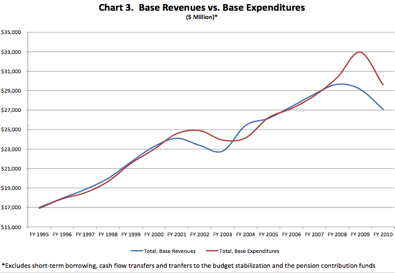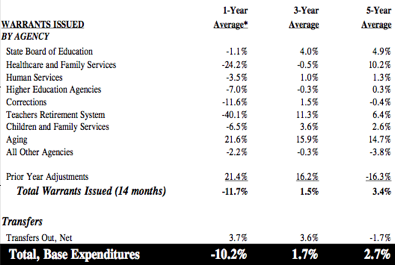
Latest Post | Last 10 Posts | Archives
Previous Post: If Taylorville is REALLY so bad, why does STOP so painfully distort the truth?
Next Post: Cardinal George backs off
Posted in:
* I like and respect Chuck Sweeny, and I don’t mean to single him out, but this sort of opinion appears to be rampant these days…
The Legislature returns to Springfield this week for three days of nothing much as far as I’ve been able to determine. The lawmakers will get their per diem payments and return home, not to come back until January.
And 2012 being an election year, there isn’t much hope that controversial work will get done then. Can Illinois wait until 2013 before problems of epic proportions created by a generation of lawmakers and governors are addressed? […]
I am talking, rather, about real problems like the state’s $14 billion debt, the worst-in-the-nation $85 billion unfunded pension liability and the billions owed to businesses and nonprofits that have performed services and provided goods to the state but must wait months to get paid.
I’m not sure where that “$14 billion debt” figure comes from, but whatever.
Chuck’s column was titled “Lawmakers know what to do; I doubt they do it.” It didn’t really contain much in the way of solutions to our immediate problems, and it showed a lack of understanding for where we’ve been. So…
* Let’s take a walk down memory lane, using actual facts and real figures. Everything I’m posting here is from a Commission on Governmental Forecasting and Accountability report.
For instance, here are base state revenues (blue) vs. base spending (red) from FY 1995 through FY 2010…

Almost the entire backlog of overdue state bills was generated during that last bizarrely unprecedented spike. Illinois has been dragging those unpaid bills behind it ever since.
Look at the history and disregard the propaganda. Revenues and spending mostly went hand in hand until after the 2006 election, when Rod Blagojevich declared all-out war on Speaker Madigan and Madigan responded in kind. We had huge spending increases while revenues tanked with the international economy. I’ve always believed that Madigan deliberately tried to bring the government to its knees during this period. It almost worked. Trouble was, Rod got arrested and was then impeached, so Madigan, et al had to dig their way out of the hole they created in the wake of what was by all definitions a political civil war (a war which I supported, by the way, but also repeatedly warned of its consequences).
* The ferocity of the international collapse obviously took Madigan and others by surprise. By the time they looked up from their war, the budget had gone to heck and the piper had to be paid. Here’s revenue growth ending FY 2010…

Spending growth ending FY 2010…

Bill Brady was calling for a ten percent spending cut last year, but that was already being enforced by collapsing revenues.
* And it ain’t over. The reduction in federal help to the states will take a big chunk out of this year’s budget…
Couple the lower [federally reimbursable state spending] with a return to a lower [federal] match rate on what spending does take place, and federal sources are expected to fall $1.036 billion from last year’s levels.
Discuss.
posted by Rich Miller
Monday, Nov 7, 11 @ 4:44 am
Sorry, comments are closed at this time.
Previous Post: If Taylorville is REALLY so bad, why does STOP so painfully distort the truth?
Next Post: Cardinal George backs off
WordPress Mobile Edition available at alexking.org.
powered by WordPress.
How much of that spike in spending should really be listed in earlier years? My memory may be off, but I believe the expenditures look lower in the earlier years due to pension payment deferrals, pension bonds, and other short term strategies designed to balance the budget in the current year by pushing expenses to later years.
Comment by Pelon Monday, Nov 7, 11 @ 7:24 am
Rich,
Have you got the graph for the out year projections? Do the Red and Blue lines ever cross?
Comment by Cincinnatus Monday, Nov 7, 11 @ 8:58 am
=The ferocity of the international collapse obviously took Madigan and others by surprise=
What were they doing living in a cave?
Comment by Louie Monday, Nov 7, 11 @ 9:34 am
One issue I see is State expenditures increased 100% in 14 years. If the GA and executive branch had managed the budget in a manner that was even remotely responsible there would have been a surplus every year. Revenues increased about 75% from 1995 to 2009 (about 5.5% per year). If the State had controlled it’s growth to even 5% per year they would have a large surplus at this time. Of course, asking the GA to limit spending is like asking a child not to spend the dollar you just gave them as you walked into a candy store…not going to happen.
Comment by anonymous Monday, Nov 7, 11 @ 9:37 am
Oh, I heard half of the candidates last year using the same message “no cuts have been made, and not one program has been stopped.”
Thanks for a little reality.
Cincy: good question. Some key people are trying to make sure the lines do cross, with some decent multi-year plans, but it’s an uphill battle against public interest group demands, narrowly focused lobbyists, political and editorial obfuscators, and willful denials of reality.
Comment by walkinfool Monday, Nov 7, 11 @ 9:46 am
Louie: The ferocity of the international economic collapse took virtually every American Fortune 500 company, and every international financial institution by surprise, as well. How quickly we forget.
Comment by walkinfool Monday, Nov 7, 11 @ 9:52 am
I tend toward the budget hawk side of the scale, but let’s remember that much of state spending falls in the Medicaid program, and medical costs have spiked over the last 14 years. Prison populations also have grown tremendously with an associated increase in costs. And the number of k-12 students has increased as well — I think last year’s high school graduating class was the biggest ever. Add in the pension ramp and you’ve got real structural issues. Doesn’t mean there were no places to cut, but let’s keep in mind the realities behind those numbers.
Comment by Soccermom Monday, Nov 7, 11 @ 9:59 am
The graph demonstrates that base expenditures since FY09 have dropped more sharply than any other time during the period starting with FY 95.
If spending were adjusted for inflation and population growth since 1995, the actual growth has been much smaller than the graph indicates.
Comment by reformer Monday, Nov 7, 11 @ 10:25 am
The cost of the healthcare keeps spiking. The demand isn’t going down anytime soon.
Unless we can start shaving off on the right side of the equation that we pay out to docs and hospitals, it’s going to eat up everything.
Comment by wordslinger Monday, Nov 7, 11 @ 10:31 am
- wordslinger -
I think you are correct that healthcare is a big part of this challenge, but you, like many others are missing the big picture on how to change health care spending. The biggest piece of the pie where we can change health care spending requires a cultural change.
Today we use health care when we are sick. But if we started using health care to build on our own wellness, we would then start to change the cost curve. The reason is that with a better lifestyle and regular check-ups we would start catching health issues earlier. Catching them earlier would mean less expensive treatments. The benefits from this switch would be exponential.
A second cost cutting measure would be to stop paying for health care based on each procedure. Today there are tons of tests and treatments performed that may not be necessary. If we instead paid for care based the diagnosis and how closely the care matched the “gold standard” we would see fewer procedures / tests and better outcomes. Resulting in cheaper AND higher quality care.
You are right, this would be a big benefit to the bottom line for government and for our economy as a whole….but there are many other aspects of our budget that should be changed as well.
Comment by Lake County Monday, Nov 7, 11 @ 11:02 am
I assume base spending does not include the pension liability that was accruing.
Comment by BigTwich Monday, Nov 7, 11 @ 11:23 am
I agree with Rich it is all madigans, Emil jones cullerton, Quinn and blagos fault. Throw all the bums out.
Comment by Fed up Monday, Nov 7, 11 @ 11:54 am
Sorry — the type is very small on an iPhone. Now I see that the graph does not include pension contributions. But the other drivers remain.
Comment by soccermom Monday, Nov 7, 11 @ 11:57 am
–A second cost cutting measure would be to stop paying for health care based on each procedure. Today there are tons of tests and treatments performed that may not be necessary. –
I’m with you there. I have an expensive Blue Cross PPO. Due to a mixup at an emergency room one time with my kid, they thought I had an Humana HMO. Fortunately, I had my Blue Cross card.
When they thought I had the HMO, they practically threw us out in the street. When they figured out I had the Blue Cross, the tests and specialists dropped from the sky.
My wife’s old ob-gyn tried to commit serious fraud on my insurance provider, ringing us up for all sorts of high-risk procedures and tests that were never performed.
She asked us to play ball with her when she got called on it by Blue Cross. We did not. But she still practices in town. We just get dirty looks from her at the grocery store
Comment by wordslinger Monday, Nov 7, 11 @ 1:21 pm
the most obvious things I see are that spending grew 3 1/2 times as fast as revenue, and Healthcare and Family Services and Aging stand out as champions of unsustainable growth rates
Comment by steve schnorf Monday, Nov 7, 11 @ 4:29 pm